Go to All Blogs | Birding Blogs | USA Birding Tours | Ohio Birding tour | Ohio Day Tours | All our birding tours
By Chris Lotz
This blog was last updated on 20 December 2019 and should be updated often – perhaps once a week – during December as I try to see the last three species. Please scroll down for the 20 December update.
I’m a new birder in Ohio, having lived here for less than two and a half years. I came to Columbus from South Africa to open the new American office of Birding Ecotours. When I first arrived, I was still in the habit of always being nervous when birding, trying to spot megafauna such as lions, leopards, wild dogs, crocs, hippos, and elephants that could eat or trample a birder. Apart from this the actual birding as such was easy, as I grew up with South Africa’s birds and knew them like the back of my hand. But arriving in Ohio I had to learn not only how to identify everything, including the myriad sparrows (visually as well as by their songs and calls) but also where to find things. Exactly what habitat should I look in to find a Sedge Wren, for example? And when and where do I try and locate a Fox Sparrow? Of course this was excellent fun, and the mammals I found also just seemed less intimidating than the African ones – like a raccoon looking in a garbage bin for something to eat or a woodchuck standing up and peering around.
After one and a half years of getting to know the birds here, at the start of 2019, I found myself wondering whether it would be possible for me to see 300 species in Ohio in a single year. The main obstacles, though, are that:
1) I travel abroad a great deal – e.g. Sri Lanka in January, South Africa in February, April and September, Norway in June, Bolivia in October/November, etc. I miss lots of birding time, often during strategic migration periods.
2) When I’m not away, I always have a mountain of office work – basically I have a full-time job (and a very busy one at that!).
Within these constraints, I wanted to do an experiment to see whether I could actually see 300 species in a single year within Ohio.
I had to leave for Sri Lanka on January 10, then immediately go to South Africa, basically only returning to Ohio in March. So I tried frantically for the “January 100” but only got to 90 species (during the first 10 days of the year). In March, when I found myself back in America, I had to play catch-up with all the other local birders who had seen well over 100 species by then. When I am in Ohio I bird hard and work hard. But the next problem was that I had to go back to South Africa for almost the whole of April as well as the first few days of May. April was an insane month for vagrants, all of which I missed. How sad!
May was an absolutely frantic month, and because I effectively missed April, I had to bird like crazy in May not only for the rare/vagrant birds, but also for all the normal species other birders had already seen in April. So I missed things like Kirtland’s Warbler (and 2019 was apparently a historic year for them, with more of them than ever before turning up), not to mention Connecticut Warbler and a late Eared Grebe that cooperated well for so many other birders, but which I missed. I did manage to successfully chase some MEGA species though, such as Swainson’s Warbler and Townsend’s Warbler – hooray for those, at least!
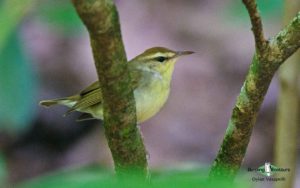
I’d been told that to have any possibility of reaching 300 species by the end of the year I would have to have seen a bare minimum of 250 species by the end of May, “but even then it will be very difficult”. Well, I actually managed to reach 268 species by the end of May! But I’ve been analyzing what birds are still possible, and basically I’ve already seen all the code 1 birds of the Ohio Birding Checklist with Difficulty Codes of the Ohio Ornithological Society and all but a handful of code 2 and 3 species, which I should still manage to see this year. Using “advanced maths” to try to assess how many code 4 species I should still see this year and adding this number to the handful of code 2 and 3 species I should see without problems leaves me with 17 vagrant birds that I have to see between July (when I return from the Norwegian Arctic – Svalbard) and the end of the year. That’s going to be extremely tough, I reckon. It basically means three really unlikely vagrant species every month, yet I’ll be missing some of the peak fall migration months and also trying to work a full-time job.
But it’s not looking good for me to reach 300 species in Ohio this year, I have to say, even though I reached 268 by the end of May, my last ones being Neotropic Cormorant at Battelle Darby Creek Metro Park, and Western Cattle Egret at the Ohio State University Airport Livestock Facilities.
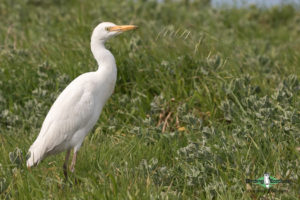
Whether I’m successful or not, this fun quest to try to see 300 bird species this year has been amazingly rewarding. I’ve stumbled across American Beavers, Coyotes, and even a close-up Bobcat (deep in the Shawnee forests of southern Ohio). And I use this as motivation to get to know Ohio well. I’ve been to a large proportion of its 88 counties and have been on a countless number of small country roads. The camaraderie is one of the most rewarding elements, though – meeting up not just with one’s feathered friends but, even more importantly, catching up with one’s human friends while out birding and chasing.
12 September 2019 update – how is my quest to see 300 birds in Ohio this year going?
It’s going slightly better than expected, but I still don’t think I’ll reach 300 birds in Ohio this year. Three months ago, on June 2 when this blog was last updated, I was on 268 species. Little did I know that I would have to wait a full 1.5 months (until July 22) before seeing my next bird for the year! There were three main reasons (I can think of) for me not seeing anything new for the year for so long:
- Summer does tend to be slow from a rarity point of view.
- I’d already seen the summer-type birds early as I had tried so hard for them. Last year I left a lot of birds for July and August, but this year I saw them in May and June. These included things like Sedge Wren, Henslow’s Sparrow, Least Bittern, American Bittern, rails and others.
- (this is probably the main reason). I was, as usual, away a lot! Megan and I explored areas we hadn’t seen before by doing a road trip to Tennessee to celebrate our anniversary in early June. And then I also went to Svalbard (Spitsbergen) in Arctic Norway in late June. That took care of June for me…!
- When I did get back from Svalbard I had to catch up on my work. So, the niggling knowledge that there was a rather tricky-to-find Yellow-crowned Night Heron an hour away bothered me, but I just couldn’t justify driving there and then spending hours looking and waiting for the bird to hopefully put in an appearance.
After my 1.5 months with no new birds my luck changed. News filtered through that there was an easy-to-see Yellow-crowned Night Heron as opposed to the one that wasn’t co-operating well. I jumped at the chance of heading to Chagrin River Park just east of Cleveland, about two hours and 20 minutes from my home, when I heard there was a “reliable” Yellow-crowned Night Heron there! And what a good excuse to bird (albeit briefly) with my friend Cole Difabio, who is from that area. So, yay, number 269, Yellow-crowned Night Heron, suddenly did materialize, and that seemingly started a spate of better luck! Please see the photo of this good-looking juvenile heron here:
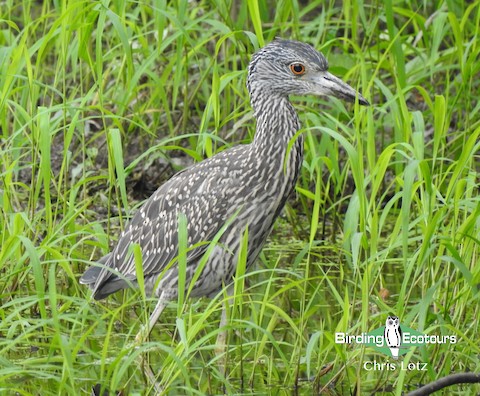
The much-awaited “fall” shorebird migration was just “wanting” to start, and I was so excited, as the onset of this would inevitably allow me to add new Ohio year birds! Shorebirds (waders to most folks outside the Americas) finish breeding in the northern Tundra early, so they are among the first of the migrants to return southward, starting in late summer and continuing through early fall. And I was not disappointed! My next year bird, number 270, was a beautiful Stilt Sandpiper at Killdeer Plains Wildlife area (thanks Cam Lee for reporting on this and advising I get there fast as the water was drying up at a rapid pace).
Then, a couple of days later, I persuaded Megan to do the 3.5 drive (and back again!) to the legendary Conneaut. This is the farthest place one can go from Columbus and still be in Ohio; it’s not far from Erie, Pennsylvania. But we did the drive, and I managed to see a new state bird (not just a new year bird), Piping Plover, as well as a couple of beautiful American Avocets for my year list! Then back to Killdeer Plains a couple of days later to see the season’s first Baird’s Sandpiper.
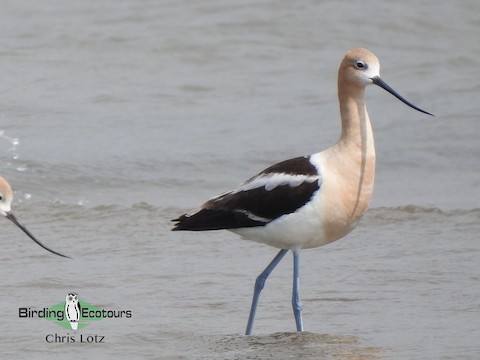
Irina Shulgina reported a Western Kingbird less than ten minutes’ drive from my home at the Ohio State University (OSU) airport livestock facility, and so we went there and enjoyed great views of this stray to the east. Then two beautiful Red Knots were reported at the legendary Wilderness Road in Amish country – it’s always good to have an excuse to visit that lovely area. And it was a true delight to see quite a number of birding friends there, including meeting a couple of Facebook friends in real life!
So by August 11 I had made it to 275, but I had to go to North Carolina to meet with my friend Johnny Wilson and to do a Hatteras pelagic trip arranged by Brian Patteson (see https://www.patteson.com/). This Gulf Stream pelagic on the Outer Banks was amazing! I actually saw a couple of lifers on that North Carolina trip (although I was, as always, anxious about being away from Ohio in case something rare might appear there, which it did, as you’ll read below). In North Carolina Bachman’s Sparrow and three pelagic species were new for me, and I also enjoyed getting reacquainted with Red-cockaded Woodpecker, Brown-headed Nuthatch, and other nice sandhill pine savanna species. Not to mention a pair of magnificent Swallow-tailed Kites that flew over the highway, completely unexpectedly, as I approached Pittsboro, where Johnny lives – further north than usual. This was actually an ABA (American Birding Association) lifer for me!
But who was to know that toward the end of my North Carolina trip a couple of Swallow-tailed Kites reportedly started frequenting a soybean field (enjoying hunting for insect food over it) in Ohio! Just a pity I wasn’t actually in Ohio…! But luckily these fabulous-looking kites lingered for at least a couple of weeks and I managed to see one of them for my Ohio year list – hooray! Seeing these kites in North Carolina and now in Ohio brought back great memories of seeing them for the first time in my life during my first trip to South America. I went to Peru and saw a whole flock of them in front of a dark gray sky just as a big storm was brewing, at Explorer’s Inn, Tambopata National Park, south-eastern Peru in the mega-bird-rich Amazonian lowlands.
Meanwhile, Ohio’s first Limpkins (and there seem to have been at least three separate individuals in Ohio this summer, believe it or not!) had been really bothering me. In general, one of the Limpkins would be reported late in the day but it would be too far for me to get there before dark even if I dropped everything and immediately started driving. Many birders who lived closer would see the Limpkin that day, and then many birders would try again early the next morning, the latter always without success. I was too busy with work to be one of those birders who put in the hours the day after any report came through, and it would anyway have been futile it seems. Quite honestly, I really didn’t think I was going to see one of these famous Limpkins. But then, in late August, I suddenly noticed a different pattern. Usually the one at Magee Marsh is seen in the late afternoon or evening. Most people had been trying in the mornings. But the Limpkin had been seen for three afternoons in a row. So as soon as Megan and I had time a couple of days later we drove the two plus hours and started searching. Other birders were already there and were not finding it. But at around 5.30 pm I suddenly saw someone had e-birded it about an hour earlier (just before we got there, basically!). I excitedly located the e-bird report and told the other birders who were searching in the area about it. A birder from Michigan didn’t believe it and went back to Michigan*. The remaining birders searched and searched and we wondered why we couldn’t find it. I then decided to get out of the heat, get back into the air-conditioned car, drive 10 yards at a time, and at each stop scan so incredibly carefully. After a couple of stops, looking through long grass with binoculars, I could hardly believe my eyes when suddenly this beautiful, spotted, brown bird with an ibis-like bill entered my field of view. Wow, how incredible! Limpkin for my Ohio list!
*We like the friendly rivalry with folks from Michigan (who aren’t good at football either), but really this person did vanish shortly after I told him the bird must actually be around as it had just been e-birded! Ha-ha!
By the way, do you reckon that you have a top photo for the Magee Limpkin? If yes, do e-mail it to [email protected] if you want it included (with acknowledgement) in this blog.
From the Limpkin site (Magee Marsh) it was just over an hour to Lorain, a rather scenic drive due eastward along Lake Erie. But we decided to act like normal people – and not birders (ha-ha) – so we actually did not drive to Lorain, despite the fact that both a Buff-breasted Sandpiper and a Laughing Gull had been pretty cooperative there (Janice Farral was one of the people who kept reporting these goodies). This is the kind of birding risk I take because I have such limited time, and all I could hope for was that both species would appear closer to Columbus soon. And believe it or not, both species did, in fact, did come through close by. One (Laughing Gull) was at Buckeye Lake, and the other one (the beautiful Buff-breasted Sandpiper) was at Shrum Mound within the Columbus area (thanks, James Muller). I had to try twice for the gull, since when Jacob Roalef and I visited the site the naughty gull was nowhere to be seen. But when Megan and I went back it was just sitting there as if nothing had happened. It was a dodgy-looking juvenile with its characteristic drooping bill.
I was also “forced” to return to Wilderness Road, because not one but at least two Western Sandpipers were putting on good shows, and I saw them quite close-up.
Hooray, I managed to get my 280th Ohio bird for the year by the end of August. The first twelve days of September have been awfully slow, though. My nemesis birds for the year include Long-billed Dowitcher (probably the easiest bird I still need) and, I guess, American Pipit. Both are luckily starting to arrive in bigger numbers, though, although I’ll go to South Africa for a family visit from September 13 to October 5. I just hope that the birding will be good between October 5 and my next trip after that, Bolivia!
And here’s a “blast from the past”. Instead of Limpkins, quite a number of which have appeared all over the Midwest this summer (including Ohio’s first ever), last year it was Roseate Spoonbills! Here’s an August 13, 2018, update I posted: “What to do when you’re awake early because of jetlag? Go see a spoonbill! Only 45 minutes’ drive from our home in Columbus, a Roseate Spoonbill at the Hebron Fish Hatchery and Wetlands, Licking, OH, has been cooperating well. According to some of my helpful birding friends it seems to be present in the evenings and early mornings (but probably less commonly any other time of the day – I’m not sure where it goes when it decides to “fly off”). This morning a couple of birders arrived at the site around sunrise (6:40 a.m.) and were treated to just over half an hour of viewing. It spent a lot of this time feeding as shown in this video. It flew off and vanished at 7:15 a.m.”
12 Nov 2019 update – only 9 birds to go, but I’m still not hopeful!
By the time I left for my Bolivia birding tour on October 30, I was doing better than expected in my quest for 300 Ohio birds this year. This is largely thanks to a nice spate of rarities. How exciting! Firstly, a Rufous Hummingbird pitched up at a private home and the owners were really hospitable and helpful to a couple of us, so I managed to add this little beaut to my year list.
Believe it or not, a Sharp-tailed Sandpiper (a rare vagrant from Asia and a bird I needed for my ABA list) then pitched up at Killdeer Plains Wildlife Area and that didn’t pose major problems as it was a very co-operative individual. Although quite a humorous thing happened. As Google Maps was telling me I was about to arrive at the Sharp-tailed Sandpiper site, I saw a crowd of birders, so I parked and walked to the group of people. A couple of folks excitedly pointed and said “hello Chris, it was just there but it flew to the left and we’re hoping it will reappear shortly”. For the life of me I was unable to see any water, so I was a bit confused and wondered why a Sharp-tailed Sandpiper would be in the middle of a prairie away from water. Then someone suggested “pishing” the bird in. At this time I thought I better ask if this was really the Sharp-tailed Sandpiper site. Haha. As it turned out, a Le Conte’s Sparrow had just been seen and a lot of people who had been looking at the sandpiper half an hour ago were now just around the corner trying to see this skulking orange sparrow! Anyway, I eventually managed to get both of them onto my year list – yay!
The next Ohio rarity that pitched up was a Purple Gallinule at Lorain Harbor (thanks Janice Soos Farral!). And then “bingo”, a Vermilion Flycatcher in Wayne County, just as my colleague Jacob and I were driving past the area on our way home from Cleveland – great timing for a change!
Tantalizingly, a “chase-able” Pomarine Jaeger pitched up not much more than an hour from my home at Pleasant Hill Lake, just after I’d left for my Bolivia trip! What a nightmare. These “inland” jaegers that are away from Lake Erie are far easier to see than the ones one tries to observe during “Lake Watches”. These often involve standing in the bitter cold when there are strong onshore winds blowing birds towards the land.
Due to political problems in Bolivia, our birding tour group actually decided to head home early, luckily after seeing the Critically Endangered Blue-throated Macaw and other incredible birds. But I was a couple of days too late for that pesky Pomarine Jaeger. NOOO! Anyway, Bill Ohlsen found a Brant at Lorain a couple of days after I returned from Bolivia, and not too far away I also managed to catch up with an Eared Grebe, a bird I’d narrowly missed at the start of the Biggest Week in American Birding earlier in the year (once again because I was out of the country!).
I now find myself at 291 species for the year! There are 50 days of birding left and I only “need” nine more species! Here’s a list of what I think are the most likely species to get me through to 300 (please contact me if you find any of these in Ohio between now and the end of the year!):
- Snow Bunting – this should be the easiest one. There are stacks of them all along the Lake Erie shoreline right now (according to my e-bird alerts) but sadly I dipped them when I was there a couple of days ago but did see the two much more difficult species, Brant and Eared Grebe…
- Common Redpoll (or how about a Hoary Redpoll?)
- Red Crossbill (or how about a White-winged Crossbill?)
- Evening Grosbeak
- Snowy Owl
- Little Gull
- Three or four rarities please! I’ll need these to make up the total of nine birds I still need, to reach 300 this year!
What are my worst misses for this year? Species that I’m unlikely to see now that winter is busy arriving? First of all, that beautiful male Painted Bunting that pitched up in Ohio last May. I really should have gone for that one earlier, as it did stick around for quite a few days. Michael Lamont and I were a day too late. Connecticut Warbler. I could have counted the one that Dylan Vasapolli and I briefly heard during the spring, I guess. Kirtland’s Warbler. This was a “bumper” year for them at the Biggest Week in American Birding, but they were earlier than usual and I only arrived back from South Africa in time for the second half of this epic event. And, I missed both ibises and both godwits. I now have to hope that I can make up the remaining nine species with winter type species and rarities.
I managed to add 11 species since my last update two months ago. I’m pleased to say that I’m a bit closer within reach of 300 than I expected, by this time (12 November). I’m still not optimistic though, because I was out of the country so much, including during strategic migration and rarity times (e.g. April and early May – bad times to be away from Ohio if you’re trying for 300 species in a year!). But I’m a little more optimistic than I was a couple of months back, at least. I guess there were more rarities than I expected…
Let’s hope – nine more to go and 50 days!
29 November 2019 update – 33 days left and 5 more birds to go!
Ohio’s first Tropical Kingbird pitched up in Lake County east of Cleveland. Needless to say, this was a truly unexpected addition, bringing my total to 292. I did also manage to add the easiest species I still needed, Snow Bunting, while in the northern parts of the state near Lake Erie.
The next weekend, Jen Brumfield found not one, but four, Purple Sandpipers right across from the Rock ‘n Roll Hall of Fame at the 9th Street Pier, right in the middle of downtown Cleveland! And they were co-operative, with people reporting them at least every hour as the morning progressed. So Megan and I decided to do the 2 hour and 10 minute drive. When we arrived, there was already a small group of other birders there, and a couple of my birding friends very kindly offered me scope views. I didn’t even put my jacket on (and it was c-o-l-d!) before seeing one of the Purple Sandpipers through Beth’s scope. This was an ABA life-bird for me, a species I’d only previously seen in Norway, so all the better – yay! After enjoying the Purple Sandpipers, we headed eastwards to the amazing Sims Park, a place that often hosts all three scoter species in winter, along with thousands of Red-breasted Mergansers and other “sea” ducks. My main goal, however, was to try and catch up with a Black-legged Kittiwake and a jaeger that had just been reported there within the last hour. Sadly, we were too late and couldn’t relocate either. But I was more than happy with today’s Purple Sandpipers!
Last but not least, a couple of days ago three of us visited East Fork State Park beach, where local Donald Morse Jr. located a Pacific Loon, which provided great views (among at least ten Common Loons). This brought my total to 295 bird species for Ohio this year. Five more to go! What are they going to be? (if I manage to see them, but I’m more optimistic now than in any preceding months of the year). I’m hoping for a Snowy Owl, as last Sunday’s one, the first for the season in Ohio, only stayed a day, and I simply didn’t have time to “chase” it that day. The list shown above, within the 12 November blog update, still now gives a good idea of what I still “need” to get me to 300! 33 days left, and 5 birds to go!
17 December 2019 update
Things slowed down. One expects things to slow down at the very end of November and through December, but not this much. My quest for 300 species in Ohio this year is in jeopardy at this point. I’m really getting nervous, with only two weeks of the year to go. But do see below/read further…
But it’s certainly not all doom and gloom. On 4 December, Christopher Collins messaged me to say there was not one, but two, Snowy Owls just reported in Wood Country, northwestern Ohio, two hours from my home. I dropped everything and spent the afternoon going for them. By the time I arrived, one of them had vanished into thin air, but that’s the beauty of there being two. What a magnificent bird, a huge white blob out in a field. I love Snowy Owls! And Ohio has proved really good for them the last couple of winters!
Things then went quiet for over a week, until a Harlequin Duck was reported just west of Cleveland. Luckily, I’d been putting in some 12-hour working days, so I was able to take off another afternoon to go and find this stunning duck, very rare in Ohio for sure. It was really fun to meet up with some Cleveland birders.
I was really hoping that the 14 December Lake Erie “pelagic” arranged by the “BSBO” or Black Swamp Bird Observatory (see here for more information about these birding boat trips) would generate a couple of new year birds to get me very close to 300. But sadly, nothing new materialized. It was fantastic, though,getting close-up views of a Purple Sandpiper on a breakwater, and there were also a couple of Iceland Gulls around. But these beauts didn’t help me increase my bird count for the year. A few of us on the boat heard the news that a Prairie Falcon (a mega bird for Ohio!) had just been photographed (by Aaron Nisley), and we almost jumped off the boat and swam to shore as we really wanted to see it! The problem was that this Prairie Falcon was near the Snowy Owl site, two hours from Cleveland (where we were) and then two hours from home. But a few birders on the pelagic persuaded me to try for it anyway. A lot of birders spent the afternoon searching, but to no avail. I plan to try again later in the week… What a busy Saturday this turned out to be, covering a great deal of ground.
So I have managed to reach 297 (by 17 December), and have barely two more weeks to find another three species. It’s quite possible, but at this point I really do need a good amount of luck to make it to 300. It could just as easily go either way – I’m giving myself a 50-50 chance at this stage. Some of the more likely species I still could get include Prairie Falcon, Golden Eagle (which I was sure I saw midway to Cleveland on my way to the Harlequin Duck, but it being such a rare bird in Ohio I didn’t count it without a photo), Little Gull, Common Redpoll, Evening Grosbeak, and Red Crossbill. Let’s hope at least three of these play ball and cooperate.
I did have a bit of a distraction from this Ohio birding. I had a lot of fun birding with some Michigan birders just across the state line, three hours from my Columbus home. Ypsilanti, Michigan, was the place, and the massive Gyrfalcon was the target. This is a typical falcon in terms of its speed and general behavior, but the thing is virtually the size of a Red-tailed Hawk! I was truly struggling to imagine such a humongous falcon, so I made the trek to go and try to get this as a world life-bird and see what such a massive falcon was really like. I’d actually tried once before a week or two prior (with Steve Landes), but missed it (falcons can be mega-tough). So a second try was in order. What a bird! I saw that it had been reported half an hour before I arrived and was not hopeful about relocating it. But after half an hour I did suddenly see it sitting on a fence! A bunch of us spent 3.5 hours chasing it around – not easy to do as the bird moves at lightning speed and doesn’t sit in one place for more than about 20 minutes at a time. Some of us were lucky enough to get extremely close-up views of this magnificent bird as it sat on the Willow Run airport fence. At other times it was more distant, sometimes sitting on the ground, at one point perching on an orange cone on the airport grounds, sometimes sitting in large trees, and at other times on top of the dump adjacent to the airport. At one time it shot out to catch a Mourning Dove! Below is a photo that my friend Michael Lamont took of it:
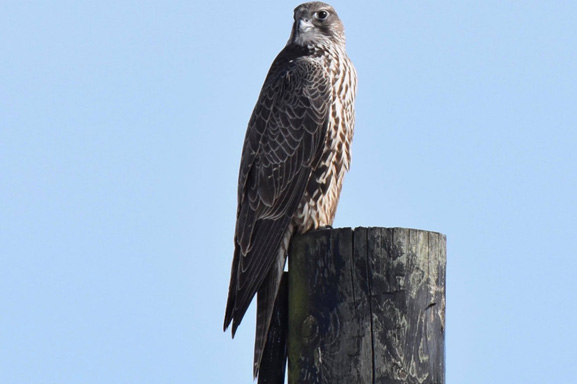
20 December 2019 update
Just as I was getting really worried about still needing three species within a short period of time, a Harris’s Sparrow pitched up at feeders at an Amish farm near Millersburg. Yay! However, since it was in completely the wrong direction, it also put me under pressure. I had allocated a chunk of Thursday (with no other time available due to work pressure) to go and search for Prairie Falcon in northwest Ohio, but now had to first drive all the way to Holmes County, reducing valuable searching time for the falcon (as I only had Thursday available this week for birding). But what a marvelous day it turned out to be! My friend Chad Pumpelly and I left Columbus at 5.30 a.m., got to the Harris’ Sparrow site at sunrise, found this beautiful bird (a male) after about half an hour, and were then able to cut across the state far westward, making it to the Prairie Falcon site soon after 11 a.m. Before leaving the Harris’s Sparrow site we managed to catch up (albeit briefly) with Robert, the owner of the amazing birding optics and clocks store, Time and Optics (https://www.timeandoptics.us/); Robert had traveled the mile or so from his store to come and look for this rare Ohio bird.
Falcons, which cover so much ground (this Prairie Falcon seems to cover an area of at least 8 x 2 miles, based on reports by other birders over the last couple of weeks), are tough birds, and I knew it would require a huge amount of luck and intense searching, to find the falcon within five hours (which is all I had). The falcon wasn’t at the “usual” sites, but after about an hour of searching, Paul Jacyk actually managed to locate the bird a couple of miles away and we rushed over. Sadly the bird had gone by the time we arrived. But several of us drove in the direction Paul had seen the falcon flying, and after a while Alex Eberts managed to relocate the bird sitting in the middle of an open field, eating! So, we got good scope views. After a while the bird took off and started flying toward us, and, amazingly, actually flew right over! What a magnificent view of a stunning bird!
That was number 299! So only one more to go before reaching the magical 300, and I have over ten days left. It’s looking more promising right now. Let’s hope!
